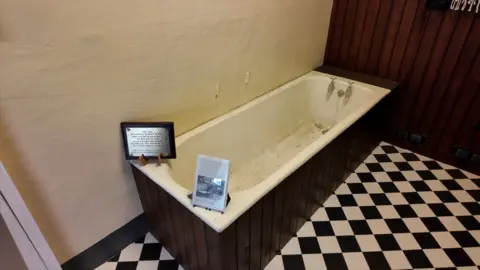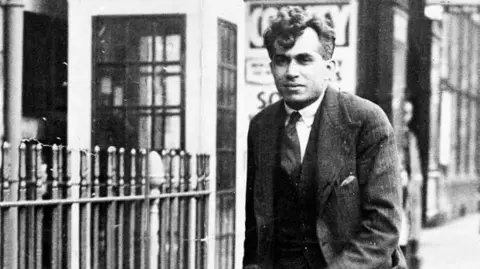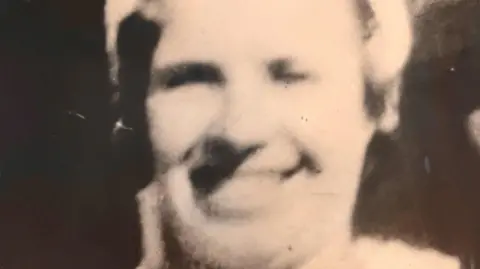The murders that revolutionised forensic science
 University of Edinburgh
University of EdinburghNearly 90 years ago, a Lancashire GP murdered his wife and their maid before dismembering the women's bodies in a bath tub and dumping their remains in a ravine more than 100 miles away.
- Warning: This article contains distressing content and details of forensic techniques
Dr Buck Ruxton was only brought to justice - and sent to the gallows - thanks to pioneering forensic work that has become an integral part of modern policing.
Jurors only needed an hour to see through the doctor's lies and find him guilty of murdering Isabella Ruxton and Mary Rogerson in Lancaster.
Pivotal to the prosecution's case were ground-breaking advances in forensic science which linked him to his victims' remains, which were found dumped beneath a bridge over a stream in Moffatt, Dumfriesshire, in September 1935.
"He dismembered the bodies in a really brutal way," said Sabine Skae, curator of a forensic science exhibition at Lancashire Police Museum.
She said Ruxton put the women's remains "in a fast car that he hired and - what I found really distressing - then drove with his son" for hours, across the border into Dumfriesshire.

The body parts were sent to Edinburgh University for examination, where they were also analysed by forensic scientists and colleagues from Glasgow University.
Back in Lancaster, meanwhile, Ruxton was offering various explanations for the disappearance of his wife and their maid.
The popular GP had been jealous of his wife's friendship with other men, and spread malicious rumours about her.
Unbeknownst to Ruxton, though, pioneering techniques were being used to recover fingerprints from one of the badly damaged bodies.
Identification was also aided by experts superimposing photographs on to one of the skulls.
Finally, Ms Skae said the scientists used their knowledge of entomology to establish time of death "really conclusively" based upon the life-cycle of maggots.
'Revolutionary'
Adam Taylor, professor of anatomy at Lancaster University, said Ruxton had "done everything he could to make the women unidentifiable using techniques that were available at the time".
He added: "Even back then, they relied on dental records and there had been really clear efforts to remove any features.
"When the police and the various professionals that were involved in the case came together it was very obvious that someone with anatomical knowledge had been involved.
"The investigators at the time had to push forward to get to the next level.
"Their ability to look at the skulls and match them up with photographs was revolutionary at the time."
 Getty Images
Getty ImagesThe weight of scientific evidence against Ruxton clearly influenced jurors, who took barely an hour to find him guilty as charged.
"It would have been very difficult to prove the case against him without the forensics," said Prof Taylor.
"He was a doctor that did his operations and consultations at home so just having blood around his house wasn't enough to give a conviction."
He said prosecutors realised members of the jury "could look at the studio portrait and the skull comparison and understand it".
The Ruxton investigation changed policing forever, agreed Ms Skae.
"A big consequence was that [police forces] realised they needed in-house [forensics] expertise and couldn't rely on universities.
"Following the investigation, someone from the fingerprints department in Glasgow was poached to set up a new department for Lancashire Constabulary because they realised they needed to get ahead of the game."
 University of Edinburgh
University of EdinburghFor decades, the bones of Isabella Ruxton and Mary Rogerson - as well as other evidence from the case - were stored in boxes in a vault at Edinburgh University.
Little is known why they were retained, but the assumption is that they were kept for further medical research.
Interest in the Ruxton murders was reignited recently when the university heard from an academic in the Netherlands researching the history of forensic medicine.
An appeal was made to trace the women's descendants after their skulls were rediscovered in a storeroom.
'Spread rumours'
Ms Skae said visitors to Lancashire Policing Museum, found within Lancaster Castle, would see reminders that some societal attitudes to domestic violence have barely changed in 90 years.
Before her disappearance and murder, Isabella Ruxton accused her husband of domestic abuse.
Police did not take any action, said Ms Skae.
"When Ruxton was found guilty, 8,000 people signed a petition to have his death sentence commuted," she added.
"Because he had spread rumours that his wife was having an affair it was considered that 'she had it coming'.
"A case like this has parallels with today. I still meet people who think 'If he'd just killed his wife, he would have been alright'.
"These sorts of attitudes to domestic abuse are still around today and unfortunately we're still looking at women getting killed in the home."
Ruxton was hanged in Manchester on 12 May 1936.
Listen to the best of BBC Radio Lancashire on Sounds and follow BBC Lancashire on Facebook, X and Instagram. You can also send story ideas to [email protected] and via Whatsapp to 0808 100 2230.
